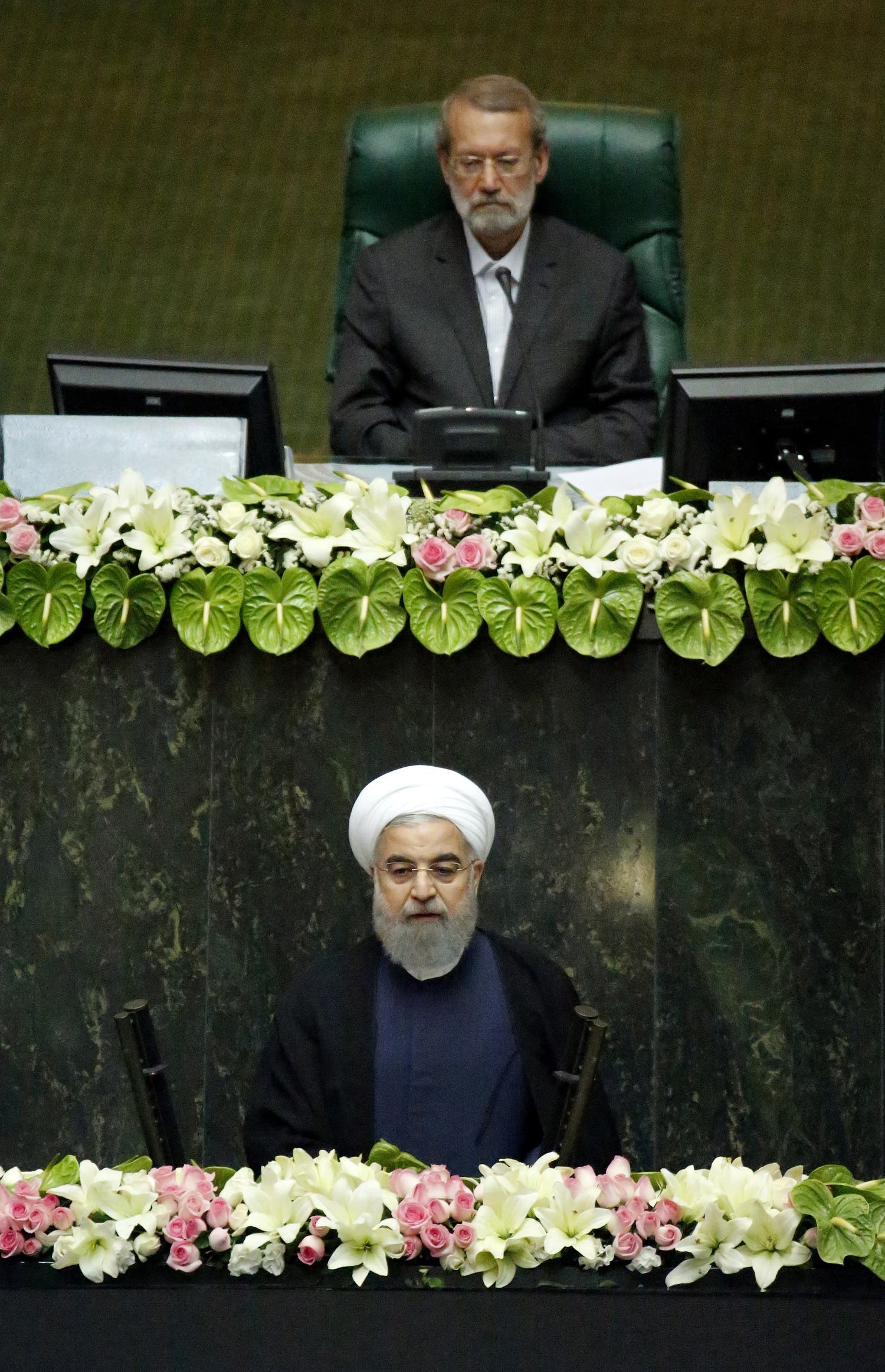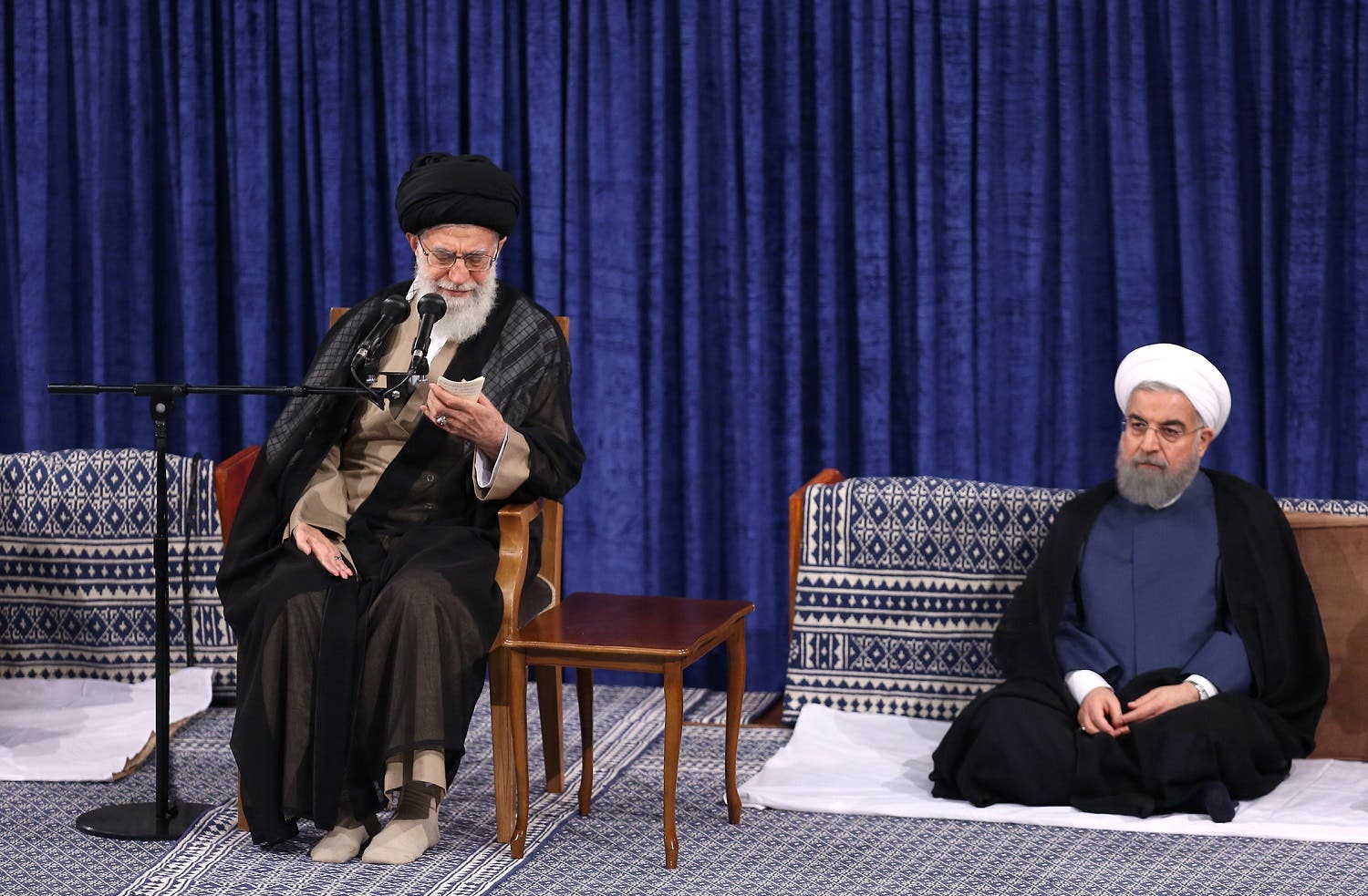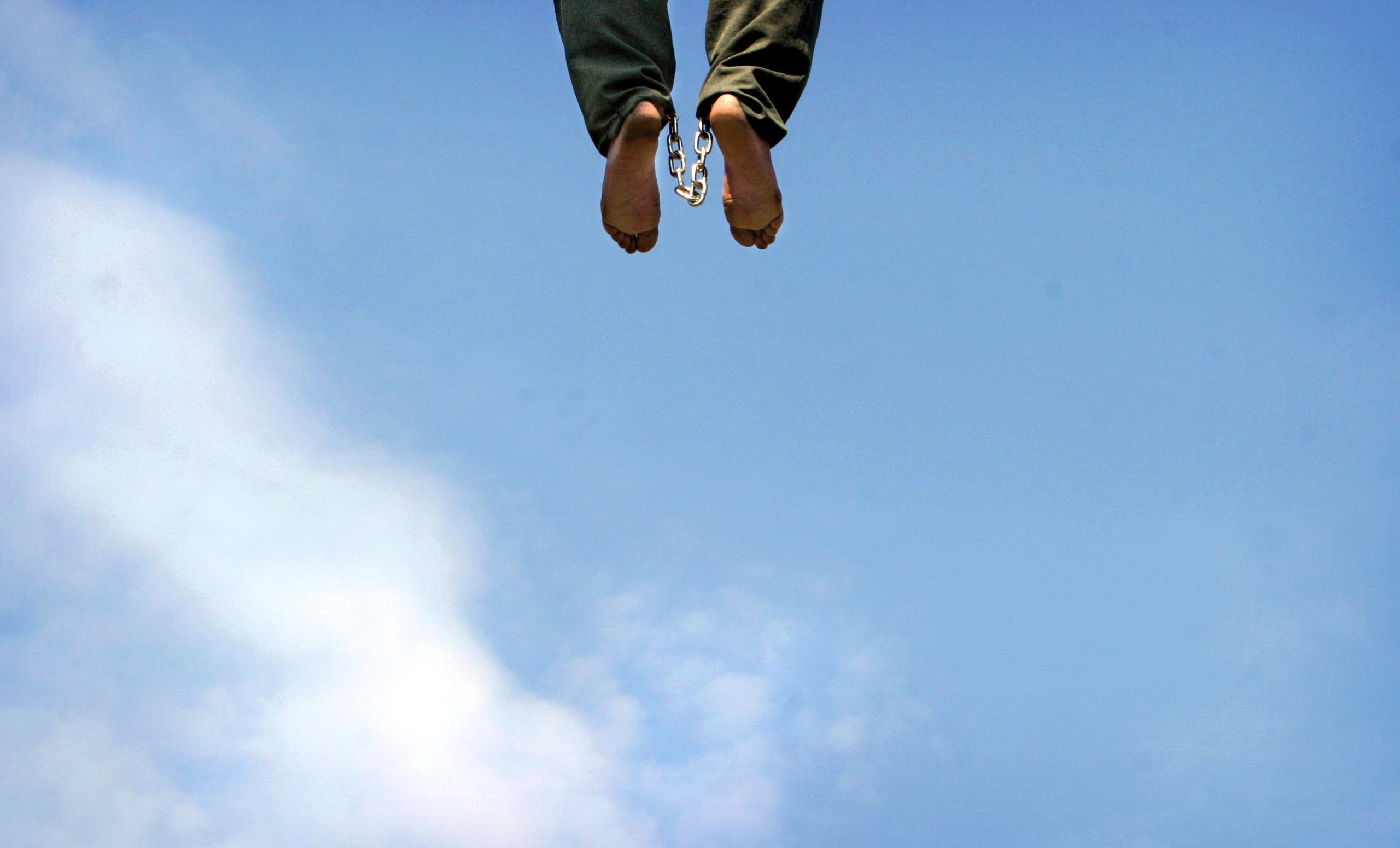 |
Iran's dissidents deserve a hearing
|
Hassan Rouhani was sworn in for his second term as president of Iran on August 5, surrounded by fresh flowers, fervent followers, and around 500 foreign officials. Representatives of the United Kingdom, France, the United Nations, and the Vatican rubbed shoulders with the Syrian prime minister, Hezbollah second-in-command Naim Qassem, Palestinian Islamic Jihad leader and FBI Most Wanted Terrorists list member Ramadan Abdullah Shallah, and murderous Zimbabwean dictator Robert Mugabe. The Westerners didn’t seem uncomfortable in such company; indeed, European Union foreign policy chief Federica Mogherini was described as the star of the show after Iranian members of parliament elbowed through the crowd to take selfies with the diplomat.
But why should they have been bothered? They were in Tehran, after all, to celebrate the renewed rule of a man who has overseen a steady increase in killings—Iran has the world’s highest per capita execution rate. Three days before Rouhani’s inauguration, Amnesty International released a damning report on conditions in the country: “Iran’s judicial and security bodies have waged a vicious crackdown against human rights defenders since Hassan Rouhani became president in 2013, demonizing and imprisoning activists who dare to stand up for people’s rights.” The press release capping Mogherini’s visit didn’t mention the European-based organization’s report—or human rights issues at all—instead focusing on “the EU’s unwavering commitment to” the Joint Comprehensive Plan of Action nuclear deal. It’s unlikely Mogherini brought up the subject even in her private meetings: She was pictured smiling in multiple photo-ops with government officials.
A month earlier, a young Iranian woman told me how she and her fellow reformers feel when they see such images. “We know with every negotiation with this regime, every shaking hand with this regime, it means one more gallows in the streets,” Shabnam Madadzadeh said sadly. “They close their eyes to human rights in Iran,” she said of Westerners who deal with the regime and many members of the media who report on it. “They kill humanity, in themselves firstly, and after that in Iran.”
Madadzadeh speaks with a seriousness that belies her age. In a hound’s-tooth blazer, black pants, glasses with wine-colored frames, and a headscarf in shades of deep rose, the 29-year-old unfurled her passion in complete paragraphs. Her mustachioed and bespectacled 32-year-old brother, Farzad, wore a black suit and white shirt, sans tie. Intense but friendly, he continued his sister’s thought: “The biggest mistake that anybody can make when looking at Iran is to distinguish between Rouhani and [Supreme Leader Ali] Khamenei. If you just look at the law related to the elections in Iran, nobody can become president of Iran unless Khamenei has endorsed them. So whatever differences they have on one thing, they are united maintaining this regime, keeping it in power at any cost.”
It’s no surprise the pair project a certain depth. Shabnam and Farzad Madadzadeh spent five years as political prisoners in Iran. The siblings were tortured in front of each other and repeatedly threatened with execution. They fled the country: separately, illegally, dangerously. What is extraordinary is that after so lately enduring such horrors, never knowing if they’d make it out alive—and learning that many friends did not—they’re able not only to smile but laugh repeatedly in the course of a five-hour conversation. They were joined in the lobby of a Paris airport hotel by a fellow dissident, Arash Mohammadi. He had the same mustache as his countryman but wore a blue blazer, blue pants, and a blue checked shirt. He’s only 25 but can be as grave as the Madadzadehs. A jocularity comes through in his playful smile, however—even though he’s been jailed three times, enduring torture in each stint.
All three escaped from Iran recently: Shabnam less than a year ago, Arash about a year ago, and Farzad just under two years ago. And here they were, cracking up in mirth watching a YouTube video. They’d wanted me to see an example of the work of Mohsen, a comedian whose parodies make Pake Shadi the most popular program on a subversive satellite television network. He’s so famous in Iran that even prison interrogators mention his material. In this one, he inserted himself into state television footage of the funeral earlier this year of former Iranian president Hashemi Rafsanjani. Khamenei watches as Mohsen leads the crowd in a chant of mourning. In the front row, top regime officials—notorious thugs such as Islamic Revolutionary Guard Corps commander Mohammad Ali Jafari and Quds Force leader Qassem Suleimani—play up their grief for the camera. Mohsen intones, “Hashemi is waiting for us; let’s go” . . . to hell. The comedian notes that Rafsanjani, as a founder of the Islamic Republic, was buried next to longtime supreme leader Ruhollah Khomeini: “Now it is Khamenei’s turn!” In between laughs, the Iranians explain just how provocative the video is. “So in the middle of the mourning ritual, he starts dancing like that. It’s ripping all the taboos,” said Hanif Jazayeri, the men’s translator. “And this means that Hashemi is waiting for Rouhani,” added Shabnam, who speaks fluent English.
The video is a high-quality production and YouTube offers an English translation. But Westerners might need explication anyway: Rafsanjani and Rouhani are regularly referred to in the West, by politicians and the press, as “moderates.” The Iranians find that notion almost as hilarious as Mohsen’s satire. I read them a line from the recent election analysis of a major American newspaper: “Many Iranians gravitate toward Mr. Rouhani because of his relatively tolerant views on freedom of expression.” All three laughed heartily. But the talk soon turned serious.
“If there was freedom of expression in Iran, what are we three doing here? I mean, leaving behind your family is not easy, you know? We had to leave our university, our family, our best friends,” Arash said. When they do talk to people back home, they do so very carefully—contact with escaped dissidents could mean imprisonment for their friends and family. The trio did not want the exact dates of their escapes published, nor the location of their current homes, other than that they’re in Europe. The siblings don’t even live in the same city, for security reasons.
Iranian foreign minister Javad Zarif declared in a 2015 interview with Charlie Rose, “We do not jail people for their opinions. The government has a plan to improve, enhance human rights in the country, as every government should.” The PBS interviewer did not question these claims. Neither did the many friendly—almost gushing—reporters Zarif spoke with on his visit to the United States last month. Arash Mohammadi and Shabnam and Farzad Madadzadeh provide more evidence—if any is needed—that such statements are simply lies.
Shabnam and Farzad were arrested in 2009, before the uprisings over the suspicious reelection results of President Mahmoud Ahmadinejad that would turn into the Green Movement. They were seized on the street. Their family, not knowing what had happened, called hospitals to see if they’d been in an accident and searched for the pair for months. Shabnam was studying computer science at Tehran’s Tarbiat Moalem University and was a leader in the reformist student group Tahkim-e Vahdat. Farzad was a nonviolent activist and supporter of the resistance group People’s Mojahedin Organization of Iran (PMOI), best known in the West for revealing details of the regime’s theretofore hidden nuclear program. “I was 23 when I was arrested, and the torture started then,” Farzad recounted. He and his sister were held separately in solitary confinement for months. Questioning would begin around 8 a.m. and last 12 to 14 hours. “In each of the interrogation sessions, I was beaten. They wanted me to confess to crimes that I had not committed,” Farzad said. They wanted him to publicly renounce the PMOI (also called Mujahedin-e Khalq, or MEK) and the National Council of Resistance of Iran. “They told me, ‘You come and do an interview against the PMOI, the MEK, and the NCRI,’ ” he said. “They would throw me on the ground and treat me like a football between three people. . . . Several times they did this to me in front of Shabnam’s eyes in order to break her.”
His sister will never forget her own months in solitary confinement. “The interrogator told me, ‘Okay, nobody can hear you. We are alone here, and we can do everything we want.’ ” She could regularly hear the voices of other prisoners being tortured; some later told her they had been raped. She was tortured herself, and the only time she could see her brother was when they brought him to be tortured in front of her. Even after she left solitary confinement, she was often deprived of the few visits allowed with family because she told them about the appalling conditions of the prisons and the gruesome treatment of prisoners. Four people would share a cell, with three thin blankets each to sleep on; windows would be left open even in winter. Captives were taken to use the bathroom just three times a day, and not at times of their choosing. Having to hold it in gave Shabnam serious medical problems. “About 11 months to a year after our arrest, there was a trial. For five minutes, it lasted,” Farzad said. They were both given five-year sentences and moved from Evin Prison to the even harsher Gohardasht Prison.
“Many of my friends during this period that I was in prison, they were executed. Some of them, they died in front of my eyes because of the illnesses they had or because they were tortured so much and because of their conditions they died in front of me,” Farzad reported. He can rattle off the names of friends executed after death sentences. “Ali Saremi. Jafar Kazemi. Mamadali Hojari. Farzad Kamangar. Farhad Vakili.” Mohsen Dokmechi died of pancreatic cancer after jailers refused him medical treatment.
He expected the same fate. “I remember the moment that I was arrested, taken to the car, and I was in front of the door of Ward 209 of Evin. I told myself, ‘You’re going in here, but you’re not coming out of here.’ Because I knew where I had come. Because I had heard what happens here.”
While the siblings each served one long sentence, Arash had multiple shorter stints in prison: He was arrested twice under President Ahmadinejad and once under President Rouhani. He was a 19-year-old studying industrial management at Tabriz University when he started gathering with other students concerned about the plight of workers in the country, especially children (factory work can start at ages as young as 6 or 7, and drug addiction with it). “If somebody just goes and walks down the streets for 10 minutes, maybe they would see a hundred kids working on the streets,” Arash said. Besides toiling in factories, children sell small items: chewing gum, socks, even “luck poems,” often randomly chosen excerpts from the work of 14th-century Persian poet Hafez. “If they don’t work, they will be starving,” Arash said. “When the government rounds them up and arrests them, instead of assisting them, helping them with their problems, they take them” to juvenile correction facilities, where the conditions can be worse than on the streets. “They are even raped there, in those centers.” He knows of a 9-year-old girl who worked in a sewing factory who underwent such trauma.
“The main problem is that the Iranian government actually doesn’t even acknowledge that such a problem exists,” Arash said. Calling attention to it was an implicit criticism of the government. “Although we were campaigning for children’s rights or worker’s rights, they would charge us for things like insulting the supreme leader, insulting the sanctities, and things that nowhere in the world is a charge,” he said. “Because the Iranian regime, they want to say that this is the best place on earth. Neither during our time in prison, neither now, the regime does not accept that it has political prisoners.” Arash was taken from his home at 5 a.m. “They told my family, ‘We have to speak to him for about an hour, then he’ll come back.’ ” He spent a couple of weeks in solitary confinement and was sentenced to a year in prison. “They constantly brought a paper in front of us and said, ‘Either you have to answer these questions like this, or you’re going to be executed.’ ”
He was next arrested after trying to aid victims of the 2012 earthquakes in the Iranian province of Azerbaijan. “The government didn’t want people to know what had happened there,” Arash said. It wasn’t the natural disaster the regime was trying to hide. “There were a number of villages that didn’t have even the basic of facilities like electricity, water,” he reported. “The IRGC, the Revolutionary Guards, had come there and they had closed off the routes to the villages.” Dozens of people were arrested for trying to help victims and locate survivors trapped under the rubble.
“The primary thing of importance for the regime is for the people not to become alert as to the problems that exist there. That’s their number-one priority,” Arash said. “It’s 100 percent a danger as a threat to the regime because it’ll become clear that for 38, 39 years, this government has done nothing for the people.”
Arash was detained yet again the day after Rouhani was announced the winner of the 2013 presidential race. “During his election and campaigning, he had promised to free all political prisoners. And so as soon as it was announced, we went in front of his campaign headquarters, and we started to chant, ‘All political prisoners must be freed,’ ” Arash said. He quickly became one himself.
That third stint in prison was the final straw. He realized that if he didn’t leave the country, he’d eventually be sentenced to death. Farzad and Shabnam also made the difficult decision to flee. “When I was released from prison, immediately a lot of problems started to come about, and I was being followed and being monitored,” Farzad said. “I couldn’t work. I couldn’t get by, live.”
Shabnam had the same experience. “When I was released, they didn’t allow me to continue my studies. They didn’t allow me to have a job.” She still worries about her female friends, especially, “under the clutches of the misogynistic regime.”
Recalling why he left his homeland reminded Arash why he started fighting for its freedom in the first place.
We are some youth, and naturally no youth want to see hardship. The youth of Iran are just like the youth in America and Europe. They want the same things. But when we reached a certain age, we looked around us and we saw that there are some things are happening, and people are being killed in the streets. People are being hanged in the streets. We also knew that in this regime, for the past 38 years there has been a current, a faction, that constantly says, “We’re reformists, we’re reformists.” But we saw that there was no reform. So we realized that the dictatorship needs to be overthrown.
And that is the heart of the matter: Western diplomats may pretend otherwise, but the government over which Hassan Rouhani presides is a dictatorship.
“As far as I’m concerned, you can’t say that one dictator is better than another dictator,” Arash said. “I was lashed in prison. For me, it did not make a difference which government’s agents were lashing me. But the pain of the lashes by Rouhani’s government were for me more painful. Because during the Ahmadinejad administration, everybody accepted it: Ahmadinejad was a dictator. But during Rouhani’s time, I felt, I saw these lashes on me, but the West did not accept that was going on. So it was much more painful for me.”
Of course, the West also sometimes found it convenient to pretend that Ahmadinejad was no dictator. Farzad recalled being in prison in 2009 when an influx of inmates arrived. Arrested supporters of the fledging Green Movement told him of their cries: “Obama, Obama, are you with them or with us?” “In Farsi, this rhymes, so it was a slogan that was chanted in the streets. But what did Obama do? Obama secretly brought a letter to Khamenei. . . . This was while people were being killed in the streets,” Farzad said. “The policy of appeasement exists. Because some people have vested interests.”
That is a succinct summary of what Iranian freedom fighters would like from the West: an end to the policy of appeasement. “I interpret the Iranian regime like a statue, like this bottle here,” Arash said, grabbing a one-liter glass bottle of Pellegrino on the table. “I believe the foundation of this regime has been destroyed by the resistance.” He made a digging motion underneath the bottle with one hand; with the other, he started shaking the bottle back and forth slightly. (It seemed a particularly Persian analogy: Engineering rivals poetry in popularity in Iran.) He has seen the cracks himself, giving the example of conversations in taxicabs. In Iran, no one has enough money to ride alone. “When there are two, three people in a car, they are so aggravated by the regime that they start to curse,” he said. (He was too polite to report exact wording.)
Back to the bottle: “But from the top, the appeasing governments in the West have tied a string to it to not let it fall down and shatter. So 100 percent, those who are holding onto this string and keeping it there are responsible for their role in it.” He is quick to point out that it’s not just Iranians such a policy hurts. “For example,
when Rafsanjani was president and Rouhani was the secretary of the Supreme National Security Council, the West kept on saying that this government is a moderate government. But it was the same government that went into Argentina and exploded the Jewish center. So this shows that when this regime is appeased, it does not just cause suffering for the Iranian people. This evilness is exported.”
They point to the Joint Comprehensive Plan of Action nuclear deal the West signed with Iran in 2015 as a prime example. “This agreement, it gave far more concessions than were necessary to this regime. They put the money—cash—in an airplane. They sent it to Iran,” Farzad pointed out. “None of that money reached the Iranian people. It reached Assad, Hezbollah.” The Iranian government received $1.7 billion directly through the deal. It will see billions more through deals the agreement has made possible: Boeing, Airbus, Renault, Total S.A., and Siemens AG are just some of the American and European companies lined up to do business with the mullahs.
That agreement was the prime focus of President Obama’s foreign policy and the reason he wrote private letters to the supreme leader, but of course Donald Trump is in power now. The three dissidents were in Paris in July for an annual gathering of members and supporters of the National Council of Resistance of Iran. Well over 100,000 people filled a stadium near Charles de Gaulle airport to listen to speakers from all over the world, including some Americans: former U.N. ambassador John Bolton, former senator and vice presidential candidate Joseph Lieberman, and Trump confidant Newt Gingrich. Throughout the weekend in Paris, from activists and their supporters alike, rang a refrain not often heard in Washington: optimism about the Trump administration. Most people were quick to note that they don’t support all or even many of the president’s policies. But they saw his tough talk about the nuclear deal during the election as a sign his Iran policy would be very different from his predecessor’s—perhaps even a “180-degree” turn, more than one person said.
The administration is conducting a review of Iran policy, which it plans to finish by summer’s end. Some pundits worry that it will make “regime change” the new goal of the United States. That’s precisely what these Iranian dissidents are hoping for. But, contrary to the assumptions of some supposed experts in Washington, “regime change” doesn’t have to be by military force.
When asked if they’d like to see America crush the Islamic Republic using bombs and tanks, all three immediately shook their heads and emphatically said no. Iranians can overthrow the theocracy from within, they insist—if the West ends the aid and comfort that allow it to hold onto power. “Definitely we have requests. We request that the West stop supporting this dictatorship,” Arash concluded. “Based on the tally that this regime has given, every day approximately three people are hanged in Iran. So for every extra day that this regime is in power, more blood is spilled in Iran. So if the U.S., and the West in general but in particular the U.S., retracts the support that they have given this regime, definitely both the people of Iran will achieve freedom sooner and fewer lives will be lost.”Tortured by 'Moderates'















